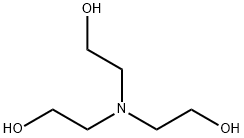Triethylamine , StandardforGC,≥99.5%(GC) , 121-44-8
Synonym(s):
TEA;Triethylamine;acid;Degassed and low oxygen triethylamine;N,N-Diethylethanamine, (Diethylamino)Ethane
CAS NO.:121-44-8
Empirical Formula: C6H15N
Molecular Weight: 101.19
MDL number: MFCD00009051
EINECS: 204-469-4
PRODUCT Properties
| Melting point: | -115 °C |
| Boiling point: | 90 °C |
| Density | 0.728 |
| vapor density | 3.5 (vs air) |
| vapor pressure | 51.75 mm Hg ( 20 °C) |
| FEMA | 4246 | TRIETHYLAMINE |
| refractive index | n |
| Flash point: | 20 °F |
| storage temp. | Store below +30°C. |
| solubility | water: soluble112g/L at 20°C |
| form | Liquid |
| pka | 10.75(at 25℃) |
| color | Clear |
| Specific Gravity | 0.725 (20/4℃) |
| Relative polarity | 1.8 |
| PH | 12.7 (100g/l, H2O, 15℃)(IUCLID) |
| Odor | Strong ammonia-like odor |
| Odor Threshold | 0.0054ppm |
| Odor Type | fishy |
| explosive limit | 1.2-9.3%(V) |
| Water Solubility | 133 g/L (20 ºC) |
| JECFA Number | 1611 |
| Merck | 14,9666 |
| BRN | 1843166 |
| Henry's Law Constant | 1.79 at 25 °C (Christie and Crisp, 1967) |
| Exposure limits | NIOSH REL: IDLH 200 ppm; OSHA PEL: TWA 25 ppm (100 mg/m3); ACGIH
TLV: TWA 1 ppm, STEL 3 ppm (adopted). |
| Dielectric constant | 5.0(Ambient) |
| Stability: | Stable. Extremely flammable. Readily forms explosive mixtures with air. Note low flash point. Incompatible with strong oxidizing agents, strong acids, ketones, aldehydes, halogenated hydrocarbons. |
| Cosmetics Ingredients Functions | EMULSION STABILISING |
| InChIKey | ZMANZCXQSJIPKH-UHFFFAOYSA-N |
| LogP | 1.65 |
| CAS DataBase Reference | 121-44-8(CAS DataBase Reference) |
| NIST Chemistry Reference | Triethylamine(121-44-8) |
| EPA Substance Registry System | Triethylamine (121-44-8) |
| Absorption | cut-off at 278nm |
Description and Uses
Triethylamine is a base used to prepare esters and amides from acyl chlorides as well as in the synthesis of quaternary ammonium compounds. It acts as a catalyst in the formation of urethane foams and epoxy resins, dehydrohalogeantion reactions, acid neutralizers for condensation reactions and Swern oxidations. It finds application in reverse phase high-performance liquid chromatography (HPLC) as a mobile-phase modifier. It is also used as an accelerator activator for rubber, as a propellant, as a corrosion inhibitor, as a curing and hardening agent for polymers and for the desalination of seawater. Furthermore, it is used in the automotive casting industry and the textile industry.
Safety
| Symbol(GHS) |    GHS02,GHS05,GHS06 |
| Signal word | Danger |
| Hazard statements | H225-H302-H311+H331-H314-H335 |
| Precautionary statements | P210-P280-P301+P312-P303+P361+P353-P304+P340+P310-P305+P351+P338 |
| Hazard Codes | F,C |
| Risk Statements | 11-20/21/22-35 |
| Safety Statements | 3-16-26-29-36/37/39-45-61 |
| RIDADR | UN 1296 3/PG 2 |
| WGK Germany | 1 |
| RTECS | YE0175000 |
| F | 34 |
| Autoignition Temperature | 593 °F |
| Hazard Note | Highly Flammable/Corrosive |
| TSCA | Yes |
| HazardClass | 3 |
| PackingGroup | II |
| HS Code | 29211910 |
| Hazardous Substances Data | 121-44-8(Hazardous Substances Data) |
| Toxicity | LD50 orally in rats: 0.46 g/kg (Smyth) |
| IDLA | 200 ppm |
| Limited Quantities | 1.0 L (0.3 gallon) (liquid) |
| Excepted Quantities | Max Inner Pack (30g or 30ml) and Max Outer Pack (500g or 500ml) |



